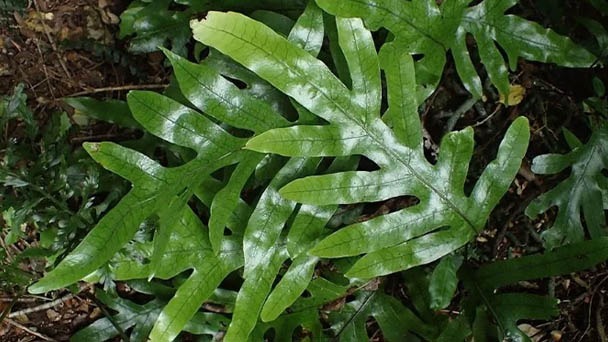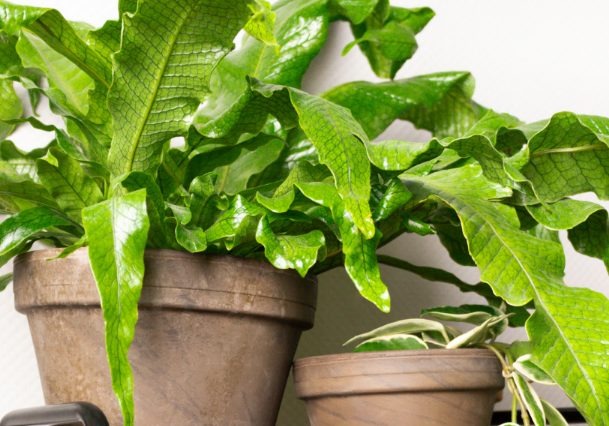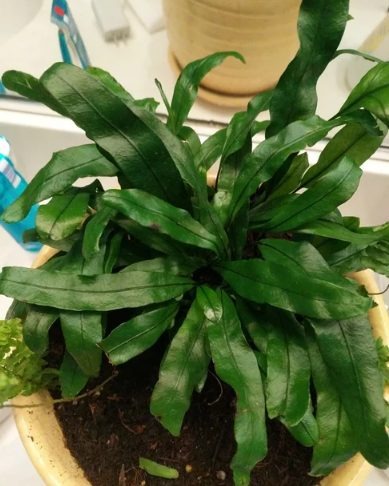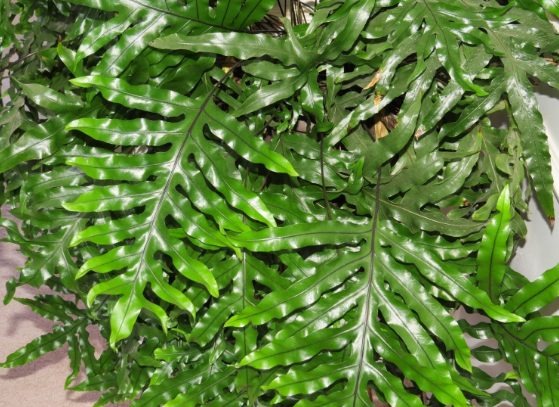Kangaroo Paw Fern - Plant Caring Guide 2023
Written by Ivy
Jan 13 2023

A Kangaroo Paw fern, or Microsorum diversifolium, is a species of epiphytic evergreen that is native to Australia and some regions of New Zealand. Its oddly shaped, firm, leathery, shiny green fronds come in a range of sizes. This is a tiny fern that only gets to be a foot tall, but its fronds can reach distances of up to three feet. The Kangaroo Paw fern prefers warm temperatures and requires little fertilizer. This is a distinctive-looking, low-maintenance fern that looks lovely in a hanging basket or placed on a table in a pretty pot.
What is a Kangaroo Paw Fern?

Kangaroo fern also known as the kangaroo paw fern or the kangaroo foot fern, the kangaroo fern (Microsorum diversifolium) reaches a height of 1 foot tall and a width between 3 and 4 feet. It's in the family Polypodiaceae. It is a native of Australia and New Zealand, and if you live in a warm climate without freezing temperatures in the winter, it is simple to grow outdoors in the ground. However, the kangaroo fern is typically grown indoors as a houseplant.
In the wild, kangaroo ferns cover large areas by spreading through underground rhizomes. It develops much more slowly indoors, but despite this, it stands out among ferns for its unusual appearance.
Not feathery like some other fern species, the gracefully arching leaves are graceful nonetheless. Instead, they are "chunky," and some say, shaped like a kangaroo paw, hence its common name. Each frond varies slightly in appearance, with some producing extended "toes" that reach out beyond the rest of the frond.
Kangaroo paw ferns have tough, leathery foliage that makes them much more resilient than some other ferns that are commonly grown indoors. Kangaroo paw ferns have a dusty blue hue when grown outdoors in a semi-shaded area, but when grown indoors as house plants, they take on a deep green color with a glossy sheen.
On the undersides of the leaves, tiny, rounded structures known as sori occasionally form. Eventually, they mature and release their miniscule spores (the genus name – Microsorum – means "very small sori"). Under the plant indoors, you might notice a fine layer of powdery spores. They can easily be removed with a clean paintbrush or makeup brush and rarely leave stains on fabric or furniture. Even better, you can grow more of this plant using the spores (more on this in a later section).
Kangaroo Paw Fern Plant Care Guide
Soil
The most crucial aspect of selecting soil for your Kangaroo Paw fern is to select moist, well-draining soil.
Kangaroo Paw ferns thrive in soil that contains some organic matter; examples include compost, perlite, and pine or orchid bark.
The soil's aeration will be improved by perlite and bark.
For even moisture retention (which is crucial for this type of fern), you could also work in some coco coir.
Light
In bright areas with bright indirect sunlight, kangaroo paw ferns thrive.
They can tolerate lower light levels, though.
Your Kangaroo Paw fern may not die from low light, but it very well may have its growth stifled.
Therefore, if your fern doesn't seem to be growing at all, it probably isn't getting enough sunlight.
A semi-shady location without direct sunlight generally yields the best results.
If you are not familiar with light levels for houseplants, you'd better have a look at our useful guide on light levels.
You will learn the definitions of bright, indirect sunlight, other specialized terminology, moderate light, and low light in this guide.
Even for novice plant parents, the definition of these terms is not always obvious. So if you're new to the world of (house)plants, please give it a try.
Watering
Keep the soil evenly and consistently moist but not soggy. Wet feet are disliked by the Kangaroo Paw fern.
When watering your Kangaroo Paw fern, it is best to use distilled water or rainwater.
Instead of using cold water, always use lukewarm water.
For the health of your Kangaroo Paw fern, consistent moisture is essential. However, you must watch out that you never overwater your plant!
Make sure to avoid watering the crown of your fern when you water it.
Your Kangaroo Paw fern's leaves drooping is a surefire sign that it needs water.
Most ferns have fairly similar watering requirements (they like to drink a lot!)
Despite the Boston fern's beauty, it must be acknowledged that it requires fairly complicated maintenance.
Definitely the better option for beginners is the Kangaroo Paw fern.
Temperature
Warm temperatures between 70°F and 75°F (21°C and 24°C) are ideal for the Kangaroo Paw fern.
Temperatures too low or too high are likely to cause heavy issues with your Kangaroo Paw fern.
Humidity
When the humidity is above 50%, kangaroo paw ferns do well.
It can be difficult to grow ferns indoors.
The fact that ferns typically require (or at least prefer) high levels of humidity is one factor that can make caring for indoor ferns challenging.
Given that many ferns are native to moist, shady forests, this is not altogether unexpected.
Does that mean that our Kangaroo Paw fern needs and loves humidity? Well, kind of.
But lower humidity levels will also make them thrive. For these epiphytic evergreen plants, even normal indoor humidity is suitable.
As long as you don't expose them to draughts, they can tolerate dry air fairly well.
Fertilizer
Feed your Kangaroo Paw fern once a month with liquid fertilizer that has been diluted to half strength during the growing season.
Reduce fertilizing during the winter or completely stop feeding your fern.

Propagating Your Kangaroo Fern
The simplest way to propagate Kangaroo Paw ferns is to divide their quickly expanding rhizomes. Remove the fern from its pot in the early spring or fall and divide it into two or three new plants. Make sure that each new section of the rhizomes has its own leaves and roots when cutting them into smaller pieces with a clean, sharp knife. Each new fern should be potted in potting soil with two inches of peat moss. Incorporate the peat into the soil. Put the new plants in low light and wait to fertilize them until new growth starts. To care for the ferns as an adult plant, keep the soil moist until they are established.
Kangaroo Paw Fern Problems
Concerns about fern maintenance? To say that I am surprised would be a lie, though.
Given that ferns are notorious for being diva-like creatures, some struggles and issues are unavoidably common.
Droopy Fronds
If your Kangaroo Paw fern looks droopy, chances are that you are keeping your fern in an environment that is too dry.
Even though Microsorum diversifoliums can usually survive in low humidity, it is still advised to keep them in higher humidity levels.
How can I, however, increase the humidity for my Kangaroo Paw fern?
There are a few straightforward methods for doing that, though. Maintaining your fern in a space with high humidity is one way to go about it.
So the bathroom could be an ideal place for your Kangaroo Paw fern, as long as it still gets enough light (see the section "Light" above)
Additionally, excessively cold or excessively warm temperatures may be the cause of drooping fronds.
Fronds that are falling off the plant
Your Kangaroo Paw fern might not be getting enough water if it is dropping its fronds.
Usually, these fronds would be yellow.
Yellow leaves and fronds are frequently signs that your watering schedule needs to be changed.
Yellow (yellowing) leaves, on the other hand, might also indicate that your fern is feeling either too hot or too cold.
This type of issue with the Kangaroo Paw fern can result from both excessively high and low temperatures.
Although the Kangaroo Paw fern does prefer warm weather, these conditions shouldn't exceed 23 degrees Celcius (72 degrees Fahrenheit).
Mushy Roots
You can almost be certain that you are watering your Microsorum diversifolium incorrectly if your Kangaroo Paw fern displays mushy roots.
Since root rot is indicated by mushy (black) roots, this is true.
Overwatering is the main culprit behind root rot. But root rot can also be caused by other factors.
Please take a gander at our articles about root rot to know more about this annoying problem:
- Root Rot Causes & Symptoms
- Root Rot Treatment
Green Or Dark Dots on the Undersides of the Fronds
These green or brown spots on the fronds, however, are completely normal and even necessary, so this is actually not at all a problem.
So what exactly are we dealing with here?
Here, we are merely dealing with spores. In the wild, spores are how all ferns reproduce. Immature spores are identified by green (white) spores.
The spores' color tends to change to a slightly brownish hue in the summer.
The spores are ripe and mature according to this.
This would be the ideal time to gather the spores if you wanted to create a duplicate of your fern.
If you are indeed interested in fern spore propagation, you'll find a detailed guide on how to do that a little bit further above.
Is the Kangaroo Paw Fern a Good Fern for Beginners?
The Kangaroo Paw fern would most likely win the prize if there were a best fern for beginners.
Kangaroo Paw ferns are somewhat more tolerant and forgiving than most other ferns.
For instance, certain ferns require high humidity levels. Not for the Kangaroo Paw fern.

Conclusion
Use a soil with good drainage, compost, perlite, bark, and bright indirect light to take care of kangaroo paw ferns. Provide a temperature of between 70 and 75 degrees Fahrenheit (21 and 24 degrees Celsius) and a humidity level of at least 50%. In the spring and summer, fertilize once a month with a liquid fertilizer that is half strength.
Frequently Asked Questions About Kangaroo Paw Fern Care
Are Kangaroo Paw Ferns Poisonous to Cats?
Visit the ASPCA (online! ), the American Society for the Prevention of Cruelty to Animals.) when wondering whether a plant is toxic or not to your pets. However, there is no information on the website regarding the Kangaroo Paw fern. It neither appears on their list of toxic plants for cats nor their list of non-toxic plants for cats.
Are Kangaroo Paw Ferns Poisonous to Dogs?
Whether or not the Kangaroo Paw fern is poisonous to dogs is a question we were unable to definitively answer. The American Society for the Prevention of Cruelty to Animals (ASPCA), which typically offers a trustworthy response to this type of query, does not include this particular fern on their list of plants that are poisonous to cats (although it does appear on their list of plants that are actually non-toxic to dogs).
How to Display a Kangaroo Paw Fern?
Given that Kangaroo Paw ferns don't grow very tall, it is most typical to grow them in a typical pot as a tabletop plant. It is also possible to grow Kangaroo Paw ferns in hanging baskets.
Is It Recommended to Keep the Kangaroo Paw Fern Outside in Summer?
The Kangaroo Paw fern can be grown outdoors in the summer, but it is not really advised because it does best when kept in the same spot constantly. This is so because ferns, like other houseplants, are extremely sensitive to changes in their environment and location. This results in (unnecessary) stress for your plant when you move the Kangaroo Paw fern from one place to another.
Latest Updated
- Benefits of Bugleweed - 7 Science-backed Health Benefits
- Bugleweed Dangers & Side Effects - Is It Poisonous?
- How to Plant Evergreen Trees - What You Should Know
- When to Plant Evergreens - Grow Guide for Evergreen Trees
- 12 Wonderful Evergreen Shrubs for Your Garden
- 12 Popular Evergreen Plants with Pictures for Beginners
- When And How To Prune A Lilac Bush Like a Pro
- How to Grow & Care for Lilac Vine (Hardenbergia Violacea)
- Japanese Lilac Tree (Syringa Reticulata) Care & Propagation Guide
- Shumard Oak Pros and Cons - What to Know
Popular Articles
- Winter maintenance of Antirrhinum Majus
- How to Grow Terminalia Mantaly Tree
- How to Grow and Care for Crossostephium Chinense
- How to grow Antirrhinum Majus in spring
- Peristeria Elata (Dove Orchid) Profile: Info & Care Guide
- Underwatered Snake Plant (Sansevieria Trifasciata) - Signs And How To Fix
- How to Care for Brazilian Jasmine Plant (Mandevilla Sanderi)
- How to Grow & Care for Graptopetalum Purple Delight in Summer
- Rosa Chinensis (China Rose): Plant Growing & Care Tips
- How to Care for Baby Sun Rose (Aptenia Cordifolia)